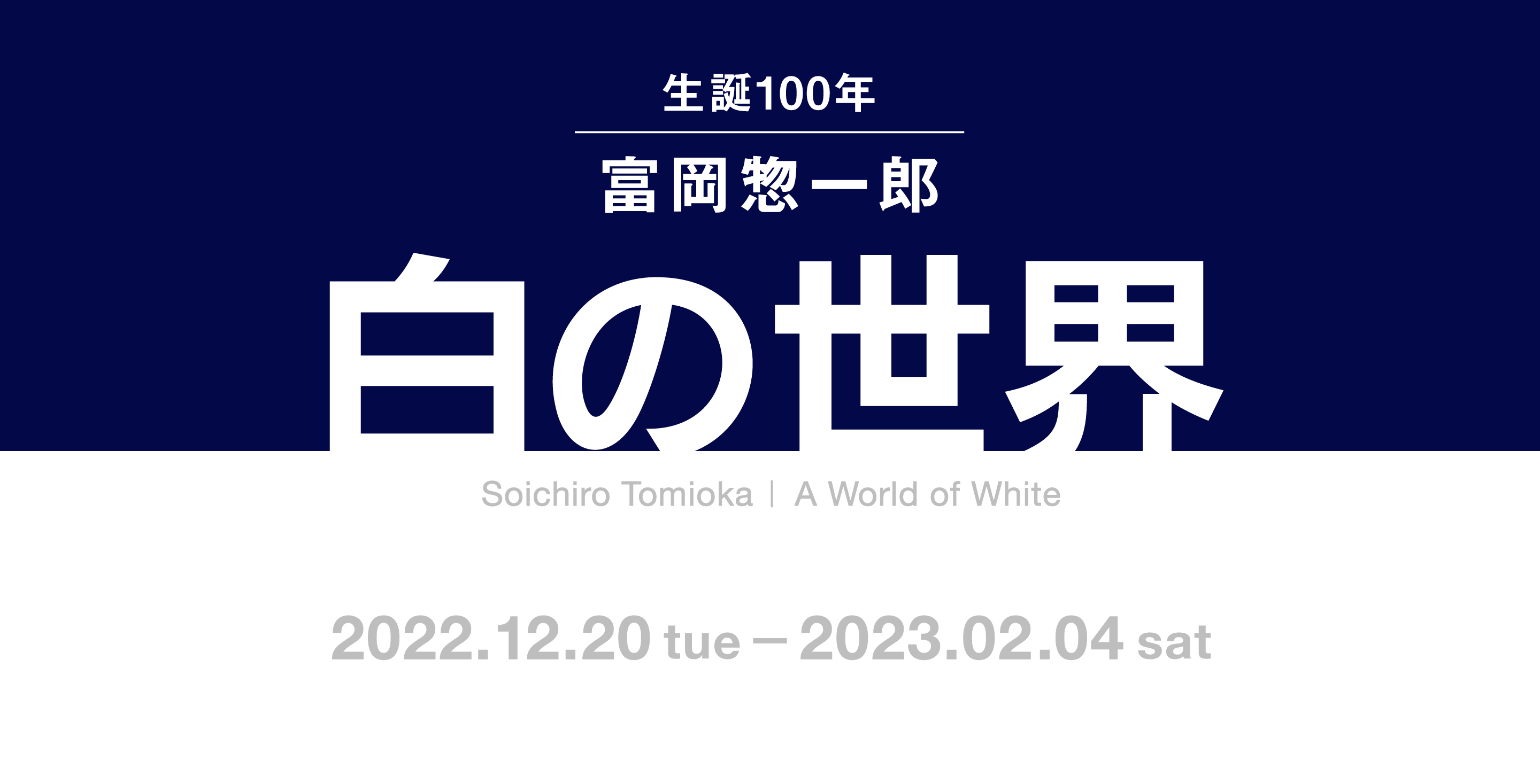

100th Anniversary Exhibition, Soichiro Tomioka|A World of White
Dates:2022/12/20 (Tue) – 2023/02/04 (Sat)
Admission: Free
Venue: Space √K (√K Contemporary B1F)
Organizer: Japan Art Inheritence Association
Collaborators: √K Contemporary
Design: Shintaro Tabara
A collaboration between √K Contemporary and the Japan Art Interhitence Association, an organization that aims to entrust legacies of the past unto future generations, Soichiro Tomioka|A World of White was planned with the intention to help foster and preserve the history of Japanese art.
In honor of the 100th anniversary of the painter’s birth, the special exhibition will be held in the contrasting, industrial interiors of √K Contemporary’s basement, Space √K.
On the Exhibition
Soichiro Tomioka was born and raised in Niigata prefecture’s snow-filled terrain. Surrounded by snow since his childhood, Tomioka continued to paint snow, a symbol of his earliest memories, throughout his career. Influenced by his love and knowledge of snow, Tomioka spent many years developing his very own white paint. Unique in color and texture, and resistant to discoloration and cracks. In turn, the snowscapes Tomioka rendered with this paint gave form to the world of white he witnessed and tried to convey throughout his career.
Completely self-taught, Tomioka was never formally trained as a painter. Since receiving the New Art Society Award at the Shin-seisaku Exhibition in 1926, the artist devoted his career to painting which, in turn, led to his receiving of the Museum of Modern Art at the 7th Sao Paulo International Art Bienal of 1963. Gaining great traction, both, locally and internationally, the artist retired from his job at the Mitsubishi Chemical Corporation in 1965 and moved to New York. For the next 7 years, Tomioka based himself in New York as he established a strong reputation through his participation in numerous exhibitions held at renowned institutions, from MoMA’s “The New Japanese Painting and Sculpture” (1966-1967) to group shows held at Musée d’art moderne de la Ville de Paris and Carnegie Museums of Pittsburgh. However, due to the increasing threat of the Vietnam War and a personal injury, Tomioka returned to Japan the following year to scout for various Japanese snowscapes to paint. Through an ambitious utilization of helicopters and Cessna aircraft, Tomioka would capture the various bird’s eye views of snow-covered mountains, plains, rivers, lakes, seas, and forests. Moving the hearts of many, Tomioka’s nostalgic works were displayed in then-current Prime Minister Morihiro Hosokawa’s official residence and on government planes. Nevertheless, much of Tomoioka’s legacy remains hidden in art history’s ever-increasing past. By placing Tomioka in the spotlight, this exhibition strives to drive viewers to address and re-evaluate his works.
Reminding viewers of, both, humanity’s place within nature and ensuing feelings of awe, Tomioka’s bird-eye works render perspectives that present views of natural landscapes that are seen, not from the perspective of humans, but of something larger. Through these humbling, omniscient scenes, these works present the notion that humanity resides in a world of unforeseen phenomena that transcends human comprehension, exists within nature’s embrace, and is alive for just a moment within the eternal passage of time.
In honor of the 100th year since the artist’s birth, we hope you take this opportunity to enjoy the winter of 2022 and 2023 together with Tomioka’s works.
ARTISTS
Born 1922 in Takada City (current Joetsu City), Niigata Prefecture. Following graduation from high school, the artist would learn to paint independently whilst working at the Mitsubishi Chemical Corporation’s advertising department. Tomioka would subsequently gain great recognition for his receiving of the 1962 Shin-seisaku Exhibition’s New Art Society Award and the 1963 7th Sao Paulo International Art Bienal’s Museum of Modern Art award. With the support of the Rockefeller Foundation’s international scholarship program, Tomioka moved to New York in 1965 and would spend the next 7 years in the city before his 1972 return to Japan. Following his return, the artist would undergo a pilgrimage around Japan’s snow country while producing more works along the way. The artist would recieve the Seiji Togo Museum Award in 1984 and began his commission to design murals for Japanese Air Force One aircraft operated by the Prime Minister’s Office in 1989. In 1990, the Tomioka White Art Museum opened in Muikamachi (current Minamiuonuma City), Niigata Prefecture. The artist passed away at the age of 72 in 1994.
Public Collections
The National Museum of Modern Art, Tokyo (Tokyo) / The Niigata Prefectural Museum of Modern Art (Niigata) /
Hakone Open-Air Museum (Kanagawa) / Akasaka Palace (Tokyo) / The Idemitsu Museum of Arts (Tokyo) / Sompo Museum of Art (Tokyo) / Nagano Prefecture Hakuba Village Government Office VIP Room (Nagano) / The International Conference Room of the Nippon Seinenkan Hotel (Tokyo) / U.S. Embassy and Consulates in Japan (Tokyo) / The Prime Minister’s Office and Government Planes of Japan (Prime Minister’s Office, Cabinet Meeting Room, Ladies’ Room, Entrance)
Born 1922 in Takada City (current Joetsu City), Niigata Prefecture. Following graduation from high school, the artist would learn to paint independently whilst working at the Mitsubishi Chemical Corporation’s advertising department. Tomioka would subsequently gain great recognition for his receiving of the 1962 Shin-seisaku Exhibition’s New Art Society Award and the 1963 7th Sao Paulo International Art Bienal’s Museum of Modern Art award. With the support of the Rockefeller Foundation’s international scholarship program, Tomioka moved to New York in 1965 and would spend the next 7 years in the city before his 1972 return to Japan. Following his return, the artist would undergo a pilgrimage around Japan’s snow country while producing more works along the way. The artist would recieve the Seiji Togo Museum Award in 1984 and began his commission to design murals for Japanese Air Force One aircraft operated by the Prime Minister’s Office in 1989. In 1990, the Tomioka White Art Museum opened in Muikamachi (current Minamiuonuma City), Niigata Prefecture. The artist passed away at the age of 72 in 1994.
Public Collections
The National Museum of Modern Art, Tokyo (Tokyo) / The Niigata Prefectural Museum of Modern Art (Niigata) /
Hakone Open-Air Museum (Kanagawa) / Akasaka Palace (Tokyo) / The Idemitsu Museum of Arts (Tokyo) / Sompo Museum of Art (Tokyo) / Nagano Prefecture Hakuba Village Government Office VIP Room (Nagano) / The International Conference Room of the Nippon Seinenkan Hotel (Tokyo) / U.S. Embassy and Consulates in Japan (Tokyo) / The Prime Minister’s Office and Government Planes of Japan (Prime Minister’s Office, Cabinet Meeting Room, Ladies’ Room, Entrance)

